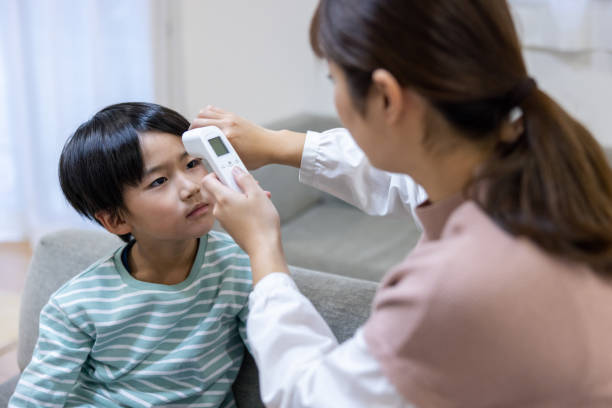A cellular thermometer used in remote patient monitoring (RPM) is a valuable tool for detecting illness and monitoring treatment effectiveness. RPM thermometers can capture precise body temperature measurements, which is crucial in identifying fevers.
This article explores the technology behind remote temperature monitoring and its significant role in improving health outcomes for patients with various conditions.
Temperature Monitoring
A fever occurs when body temperature rises above the normal average. Physicians generally consider a reading of 100.0°F (37.8°C) or 100.4°F (38°C) indicative of a fever.
Fevers are the body’s natural response to fighting infections or illnesses and are usually not a serious concern. However, for patients with certain medical conditions or those recovering from surgery, regular temperature monitoring is essential. Tracking temperature measurement changes over time helps healthcare providers assess treatment efficacy and adjust care plans as needed.
Remote Patient Monitoring Research
Remote patient monitoring uses connected health devices like weight scales, thermometers, blood pressure monitors, pulse oximeters, and blood glucose meters. These medical devices capture biometric data and automatically transmit it electronically to healthcare providers for review. Automated responses and streamlined workflows can be set within RPM dashboards and identify values outside normal readings for prompt attention.
A recent study showed the efficacy of RPM in reducing hospital visits for COVID-19 patients. Upon discharge from the hospital, patients were provided a pulse oximeter and thermometer to record daily readings. Results showed these patients sustained stable health, decreasing the probability of needing emergency department or hospital readmission.
How RPM Cellular Thermometer Technology Works
An RPM cellular thermometer uses sensor technology, wireless communication, and cloud-based systems to measure and transmit a patient’s temperature data to their physician. With cellular technology, a patient does not have to spend time pairing the medical device. The technology and process of how a cellular thermometer works are explained below.
Sensor Technology: The core component of a cellular thermometer is a temperature sensor. Various types of temperature sensors can be used, such as thermistors, infrared sensors, or digital temperature sensors. These sensors are designed to measure a patient’s body temperature accurately.
Wireless Communication: A cellular thermometer has wireless communication capabilities, often utilizing cellular networks like 3G, 4G, or 5G. These cellular connections allow the thermometer to transmit temperature readings to a central server or cloud platform.
Data Transmission: When a patient’s temperature is measured using the sensor, the cellular thermometer processes the data and converts it into a digital format. The digital temperature reading is sent via the cellular connection to a designated server or cloud-based platform.
Cloud-Based Platform: The temperature data is received and stored on a cloud-based platform. This platform is accessible to healthcare providers, caregivers, and sometimes patients through a secure login. The platform not only keeps the temperature readings but also often offers various features like real-time monitoring, data visualization, and alerts.
Data Analysis and Alerts: The cloud platform can analyze the collected temperature data over time. Algorithms and predefined thresholds can be set to trigger alerts if the patient’s temperature deviates from the expected range. Healthcare professionals are notified in real-time if a fever or other concerning temperature change is detected.
RPM Cellular Thermometer Use Cases
A cellular thermometer is practical for use in adults and children. Precise temperature tracking can make a difference in timely intervention. Remote temperature monitoring can be used for management of many condition. Some of these use cases include the following.
Infectious Disease Management
In the context of contagious illnesses like COVID-19 or flu, fever often serves as an early red flag. A cellular thermometer enables healthcare providers to remotely track temperature variations, facilitating the early detection of fever spikes and expediting medical responses.
Chronic Illness Oversight
Managing chronic conditions like diabetes, cardiovascular disease, or autoimmune disorders requires unwavering vigilance. A cellular thermometer empowers healthcare teams to remotely monitor temperature fluctuations, promptly identifying potential complications and refining disease management.
Postoperative Vigilance
Post-surgical recovery hinges on monitoring patients’ temperature trends. Cellular remote monitoring equips medical professionals with real-time insights, enabling them to address any temperature anomalies and optimize the healing process swiftly.
Empowering Pediatric Care
The challenge of monitoring temperatures in infants and young children is made easier with cellular remote temperature monitoring. Caregivers and parents gain access to live temperature data, ensuring rapid responses to fever or unexpected changes.
Elevated Senior Care
Seniors are susceptible to temperature-related health issues. Cellular remote temperature monitoring keeps tabs on in-home elderly care patients. As a result, caregivers can respond proactively to temperature fluctuations and prevent heat-related concerns.
Tenovi Cellular-Connected Remote Temperature Monitoring
With Tenovi’s infrared cellular-connected RPM thermometer, patients only have to press one button. With one touch, the RPM thermometer transmits data wirelessly through the Tenovi cellular Gateway to the Tenovi cloud without any action from the patient.
Physicians can view the vital sign readings in the Tenovi dashboard or on their platform. The Tenovi contactless thermometer uses dual-mode advanced infrared temperature technology. It offers eardrum and no-touch forehead modes, ensuring accurate temperature measurements in adults and children with an accuracy of +/-0.2°C; +/-0.3°C.
Key features include the following.
- FDA-cleared, CE, and EN certified
- No need to calibrate
- Transmits data through a cellular network with the Tenovi Cellular Gateway
- Eardrum and no-touch forehead modes
- Accuracy of +/-0.2°C; +/-0.3°C
You can schedule a free demo to learn more about leveraging Tenovi’s FDA-cleared remote patient monitoring devices and software service solutions.


